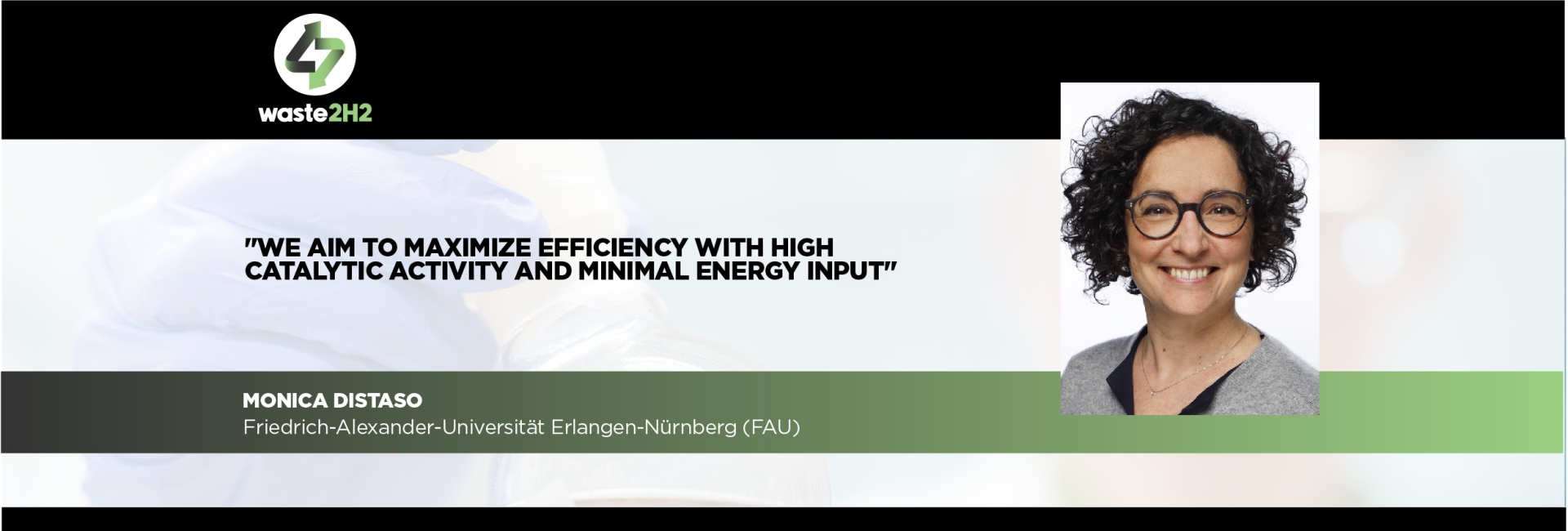
"We aim to maximize efficiency with high catalytic activity and minimal energy input."
In the pursuit of sustainable hydrogen production, catalysts play a crucial role in optimizing efficiency and minimizing environmental impact. At Friedrich-Alexander-Universität Erlangen-Nürnberg (FAU), Dr. Monica Distaso and her team are investigating metal oxide nanoparticles (MO-NPs) to develop cost-effective, robust, and environmentally friendly catalytic systems for the WASTE2H2 project. By selecting non-precious metals and adopting scalable synthesis methods, they aim to ensure not only high catalytic performance but also long-term sustainability.
In this interview, Dr. Distaso explains the key factors guiding the selection of MO-NPs, the challenges of reproducibility and scalability, and how their approach aligns with the broader circular economy principles of WASTE2H2.
1. What are the primary parameters that will guide the selection of metal oxide nanoparticles (MO-NPs) in the WASTE2H2 project?
We will focus on non-precious metals such as Mn, Fe, Ni or Cu, and their binary/ternary mixture. In this way, we would like to minimize the costs related to the use of precious metals, and reduce the dependency on critical raw materials. At the same time, the toxicity will be minimized and benign metals and precursors will be favored against more expensive and toxic counterparts. An important aspect is related to the catalytic support: we will use preferentially cheap metal oxides such as alumina and titania and we will develop nanostructured catalyst, finely dispersed onto these large surface area supports
2. How do factors like catalytic activity, stability, and environmental impact influence the selection process?
We pursue high catalytic activity and selectivity, with minimal energy input to maximize the efficiency of the process and reduce the costs. A robust catalyst shall be developed able to ensure several years of continuous activity with negligible decay of the performance. After that, the complete recover and regeneration of the catalyst with minimum thermal treatment and effective washing should be realized.
3. Which synthetic methods will you employ to produce MO-NPs, and why were these chosen? Are you considering green or scalable synthesis methods to align with the project’s sustainability goals?
Absolutely! We are considering only scalable methodologies such as wet impregnation followed by calcination under mild temperature. This approach is largely used in the chemical industry to synthesize robust catalysts. We will use air as oxidation agent for our metal oxide particles, rather than other oxidation agent, such as hydrogen peroxide, more expensive and less environmentally friendly than oxygen.
4. How will you tackle issues such as reproducibility, cost-effectiveness, or integration into existing systems?
Reproducibility is a very important issue in the design of catalytically active materials. Throughout the project and in collaboration with our partners, we will make sure that the materials produced present reproducible properties both in terms of structure and activity. Going from few grams typically produced at lab scale, to hundred grams needed for industrial scale application, we will ensure that our methodologies maintain a low environmental impact (low energy input, benign chemicals and precursors) together with excellent catalytic performance (conversion, selectivity, catalyst lifetime). This approach shall keep the low cost of the catalyst throughout the various scales. For an effective integration into existing systems, we will consider the granulation and tabletting to transform fine powders into mechanically robust catalyst bodies suitable for industrial applications.
As the WASTE2H2 project progresses, the development of efficient, cost-effective, and sustainable catalysts remains a top priority. Dr. Distaso and her team at FAU are committed to ensuring that their metal oxide nanoparticle-based catalysts not only meet the highest standards of performance and stability but also seamlessly integrate into industrial applications with minimal environmental impact.
With their innovative approach to catalyst synthesis and optimization, they are paving the way for a more efficient and sustainable hydrogen production process, contributing to the transformation of plastic waste into clean energy.